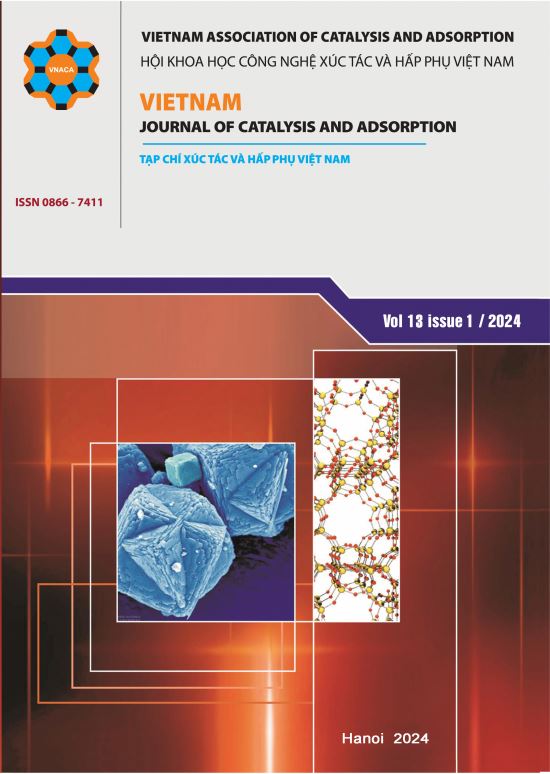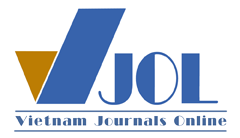Research on Pb2+ desorption and Pb recovery from halloysite adsorbent materials by electrochemical precipitation method
DOI:
https://doi.org/10.62239/jca.2024.022Keywords:
Halloysite, adsorption, desorption, Pb2+, electrochemical precipitationAbstract
Research results on the adsorption process of halloysite material in Thach Khoan, Phu Tho area for Pb2+ showed that this halloysite material has good Pb2+ adsorption ability with an adsorption efficiency of 90.75% under optimal conditions. The process of desorption of Pb2+ from Pb-adsorbed halloysite material and also recovery of metallic Pb by electrochemical precipitation method has been studied. The electrolysis process was carried out under constant current mode in 0.01M HCl electrolyte with an electrochemical system including a working electrode as an Au electrode (geometric area of 1 cm2), a reference electrode as a silver/silver chloride electrode, and a counter electrode as a Pt grid. The effects of current intensity, mass of adsorbed halloysite material, and electrolysis time on Pb2+ desorption and Pb recovery were evaluated. The obtained results show that, under electrolysis conditions: current density 5 mA/cm2, material mass 0.3 g, electrolysis time 5 h, temperature 25oC, Pb recovery efficiency reached 93.67%. The result shown that the electrochemical precipitation method is effective in desorbing Pb2+ and recovering metallic Pb.
Downloads
References
Iqbal, Z,. et al., Journal of Water Process Engineering 46 (2022) 102641. https://doi.org/10.1016/j.jwpe.2022.102641
Gupta, A., et al., Materials 14(16) (2021) 4702. https://doi.org/10.3390/ma14164702
Badran, A.M., Utra, U., Yussof, N.S., Bashir, M.J.K., Separations 10 (2023) 565. https://doi.org/10.3390/separations10110565
Trung, N.D., et al., Can Tho University Journal of Science, 4 (2016) 20-27. https://doi.org/10.22144/ctu.jen.2016.039
Nam, P.T., et al., Vietnam Journal of Chemistry 59 (2021) 179. https://doi.org/10.1002/vjch.202000148
Quaghebeur, M., et al., Journal of Environmental Quality 34(2) (2005) 479-486. https://doi.org/10.2134/jeq2005.0479a
Cela-Dablanca, R., et al., Materials 15 (2022) 5023. https://doi.org/10.3390/ma15145023
Zanin Lima, J., et al., J Environ Manage 344 (2023) 118515. https://doi.org/10.1016/j.jenvman.2023.118515
Saleh, A.D., Sirhan, M.M. and Ismail, A.S., Energy Reports 6 (2020) 243. https://doi.org/10.1016/j.egyr.2019.11.069
Zhang, J., et al., Journal of Industrial and Engineering Chemistry 73 (2019) 233. https://doi.org/10.1016/j.jiec.2019.01.029
Knežević, N., et al., Journal of Industrial and Engineering Chemistry 126 (2023) 520. https://doi.org/10.1016/j.jiec.2023.06.041
Patel, P.K., et al., Chemosphere 340 (2023) 139780. https://doi.org/10.1016/j.chemosphere.2023.139780
Cutillas-Barreiro, L., et al., Ecotoxicol Environ Saf 131 (2016) 118. https://doi.org/10.1016/j.ecoenv.2016.05.007
Tran, H., et al., Journal of Environmental Chemical Engineering 4 (2016) 2529-2535. https://doi.org/10.1016/j.jece.2016.04.038
Duyen, L.T., et al., Hội nghị toàn quốc Khoa học trái đất và tài nguyên với phát triển bền vững (ERSD) 2020, 1140-1145.
Duyen, L.T. and Bac, B.H., Desalination and Water Treatment 317 (2024) 100207. https://doi.org/10.1016/j.dwt.2024.100207
Song, Q., et al., Resources, Conservation and Recycling 190 (2023) 106804. https://doi.org/10.1016/j.resconrec.2022.106804
An, D.M., et al., VNU Journal of Science: Earth and Environmental Sciences 38 (2022) 71-79. https://doi.org/10.25073/2588-1094/vnuees.4750
Bac, B.H., et al., Engineering with Computers 38 (2021) 4257. https://doi.org/10.1007/s00366-021-01459-8
Barrads, R.G., et al., Canadian Journal of Chemistry 53 (1975) 389. https://doi.org/10.1139/v75-055
Popović, A.S. and Grgur, B., Journal of Materials Science: Materials in Electronics 34, article number 1155, (2023). https://doi.org/10.21203/rs.3.rs-2611870/v1











